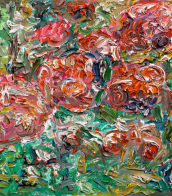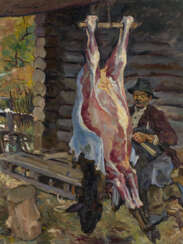brutalism


Andras Markos is a Romanian, Hungarian and German abstractionist, graphic designer and performance artist.
Andras studied fine arts at the Romanian Academy of Fine Arts, then worked for many years as a graphic designer, became a curator of medieval church art and a production designer for the Hungarian State Theater.
In 1980, Markos emigrated to Germany, also working in Vienna. By 1981, Andras' exhibitions had traveled throughout Europe and America, and he had established himself as an internationally renowned artist. He also founded several art galleries.
Markos' work is based on abstract expressionism and conceptual art. He often worked on thematic series and incorporated words and calligraphic ideas as well as collages into his images. Marcos worked in many techniques including painting on canvas and paper, lithography, silkscreen, etching and ceramics.



.jpg)
René Magritte, a Belgian artist, was renowned for his significant contributions to the Surrealist movement. His art, known for merging ordinary objects with bizarre, dream-like contexts, captivated the art world. Born on November 21, 1898, in Lessines, Belgium, Magritte's early artistic pursuits were impressionistic, transitioning through Cubism and Futurism influenced by artists like Jean Metzinger. However, his encounter with Giorgio de Chirico's work in 1922 steered him towards Surrealism.
Magritte's career was marked by various phases, each showcasing his evolving style and thematic focus. His initial foray into Surrealism began in 1926 with "The Lost Jockey" and was further solidified during his time in Paris, where he mingled with other prominent Surrealists like André Breton. Despite facing initial criticism and financial challenges, Magritte's unique blend of familiar imagery in unfamiliar contexts, like in "The Empire of Light" and "Time Transfixed," earned him acclaim.
Magritte's distinct visual language, characterized by recurring motifs like bowler hats and apples, and his exploration of reality and illusion, remain influential. His works are displayed in major galleries worldwide, continuing to inspire and intrigue art collectors and enthusiasts.
For collectors and experts in art and antiques, staying informed about Magritte's works and related auction events is crucial. Signing up for updates ensures you're alerted to new sales and events focusing on René Magritte's art, offering unique opportunities to acquire or learn more about his remarkable creations. This subscription will exclusively cover new product sales and auction events related to Magritte, keeping you updated on the most relevant information in the art world.


Nathaniel Hawthorne is an American writer and author.
Hawthorne is a recognized short story writer and a master of allegorical and symbolic narrative. One of the first fiction writers in American literature, he is best known for his works The Scarlet Letter (1850) and The House of Seven Gables (1851). Hawthorne's artistic works are considered part of the American Romantic movement and, in particular, of so-called dark Romanticism, a popular mid-19th-century fascination with the irrational, the demonic, and the grotesque.


Ulysses S. Grant, born Hiram Ulysses Grant, was an American politician and military leader who was the 18th President of the United States (March 4, 1869 - March 4, 1877).
Grant's father was a tanner and enrolled his son in the United States Military Academy at West Point, New York. Ulysses Grant distinguished himself in the Mexican-American War, then fought in the Civil War, was a brigadier general, and was given command of the District of Southeast Missouri. In March, 1864, Grant became lieutenant general and was given command of all the armies of the United States. In 1866, he was promoted to the newly established rank of general in the U.S. Army.
Grant continued as commander-in-chief after Lincoln's assassination and during the administration of U.S. President Andrew Johnson. However, the situation was such that Ulysses Grant won the next presidential election and became the 18th President of the United States on March 4, 1869. He was politically inexperienced and personally clean, but his time as president was marked by corruption and scandals. During his two presidential terms, Grant worked hard to re-unite the North and South, opposing the nascent Ku Klux Klan.
In 1877, after leaving the presidency, Grant traveled around the world with his wife, and everywhere he was received with glee. Then his attempts at business led to complete bankruptcy. Ulysses Grant spent the last years of his life writing his memoirs while battling poverty and throat cancer. With the help of writer Mark Twain, his two-volume work was published in 1885, two months before the author's death.


Andras Markos is a Romanian, Hungarian and German abstractionist, graphic designer and performance artist.
Andras studied fine arts at the Romanian Academy of Fine Arts, then worked for many years as a graphic designer, became a curator of medieval church art and a production designer for the Hungarian State Theater.
In 1980, Markos emigrated to Germany, also working in Vienna. By 1981, Andras' exhibitions had traveled throughout Europe and America, and he had established himself as an internationally renowned artist. He also founded several art galleries.
Markos' work is based on abstract expressionism and conceptual art. He often worked on thematic series and incorporated words and calligraphic ideas as well as collages into his images. Marcos worked in many techniques including painting on canvas and paper, lithography, silkscreen, etching and ceramics.


Valerii Nikolaevich Koshliakov (Russian: Валерий Николаевич Кошляков) is a Russian painter, graphic artist, author of installations, lives and works in Germany, France and Moscow.
He studied at the Rostov Grekov Art School. Koshliakov works mainly with images of architecture, which in his works appears as a memory of the former greatness. The artist uses canvas, paper, kraft, but most often cardboard, pieces of which make up huge canvases and entire installations. On this basis with diluted colors he creates a very light, yet monumental painting, which imbues the material with a web of sweat, reflecting the author's unique vision.
The works of this successful artist are in the collections of the world's major museums, including the Tretyakov Gallery, the Guggenheim Museums in New York and Bilbao.















































































